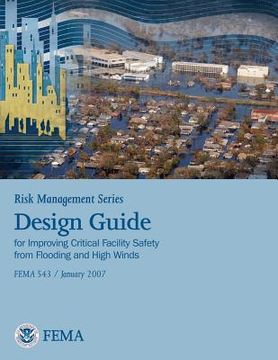Compartir
Risk Management Series: Design Guide for Improving Critical Facility Safety from Flooding and High Winds (Fema 543 / January 2007) (en Inglés)
Federal Emergency Management Agency
(Autor)
·
U. S. Department of Homeland Security
(Autor)
·
Createspace Independent Publishing Platform
· Tapa Blanda
Risk Management Series: Design Guide for Improving Critical Facility Safety from Flooding and High Winds (Fema 543 / January 2007) (en Inglés) - Security, U. S. Department of Homeland ; Agency, Federal Emergency Management
$ 58.18
$ 80.81
Ahorras: $ 22.63
Elige la lista en la que quieres agregar tu producto o crea una nueva lista
✓ Producto agregado correctamente a la lista de deseos.
Ir a Mis Listas
Origen: Estados Unidos
(Costos de importación incluídos en el precio)
Se enviará desde nuestra bodega entre el
Lunes 15 de Julio y el
Lunes 22 de Julio.
Lo recibirás en cualquier lugar de Internacional entre 1 y 3 días hábiles luego del envío.
Reseña del libro "Risk Management Series: Design Guide for Improving Critical Facility Safety from Flooding and High Winds (Fema 543 / January 2007) (en Inglés)"
On August 29, 2005, Hurricane Katrina caused extensive damage to the coast along the Gulf of Mexico, resulting in an unprecedented relief, recovery, and reconstruction effort. This reconstruction presents a unique opportunity to rebuild the communities and public infrastructure using the latest hazard mitigation techniques proven to be more protective of lives and property. Critical facilities comprise all public and private facilities deemed by a community to be essential for the delivery of vital services, protection of special populations, and the provision of other services of importance for that community. This manual concentrates on a smaller group of facilities that are crucial for protecting the health and safety of the population: health care, educational, and emergency response facilities. The Design Guide for Improving Critical Facility Safety from Flooding and High Winds (FEMA 543) was developed with the support of the Federal Emergency Management Agency (FEMA) Region IV in the aftermath of Hurricane Katrina. This manual recommends incorporating hazard mitigation measures into all stages and at all levels of critical facility planning and design, for both new construction and the reconstruction and rehabilitation of existing facilities. It provides building professionals and decision makers with information and guidelines for implementing a variety of mitigation measures to reduce the vulnerability to damage and disruption of operations during severe flooding and high-wind events. The underlying theme of this manual is that by building more robust critical facilities that will remain operational during and after a major disaster, people's lives and the community's vitality can be better preserved and protected. The poor performance of many critical facilities in the affected areas was not unique to Hurricane Katrina. It was observed in numerous hurricanes dating back more than three decades. Several reasons may explain this kind of performance. In many cases the damaged facilities were quite old and were constructed well before the introduction of modern codes and standards. Some of the older facilities were damaged because building components had deteriorated as a result of inadequate maintenance. Many fa¬cilities occupy unsuitable buildings that were never intended for this type of use. Some newer facilities suffered damage as a result of deficiencies in design and construction or the application of inappropriate design criteria and standards. The primary objective of this manual is to assist the building design community and local officials and decision makers in adopting and implementing sound mitigation measures that will decrease the vulnerability of critical facilities to major disasters. The goals of this manual are to: Present and recommend the use of building design features and building materials and methods that can improve the performance of critical facilities in hazard-prone areas during and after flooding and high-wind events. m Introduce and provide guidelines for implementing flooding and high-wind mitigation best practices into the process of design, construction, and operation and maintenance of critical facilities; and To aid in the reconstruction of the Gulf Coast in the wake of Hurricane Katrina, this manual presents an overview of the principal planning and design considerations for improving the performance of critical facilities during, and in the aftermath of, flooding and high-wind events. It provides design guidance and practical recommendations for protecting critical facilities and their occupants against these natural hazards. It presents incremental approaches that can be implemented over time to decrease the vulnerability of buildings, but emphasizes the importance of incorporating the requirements for mitigation against flooding and high winds into the planning and design of critical facilities from the very beginning of the process.

